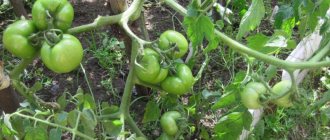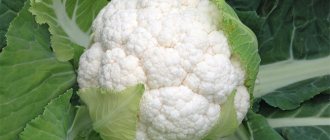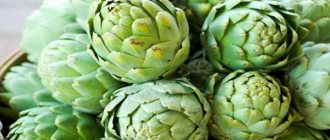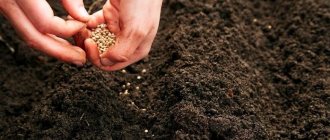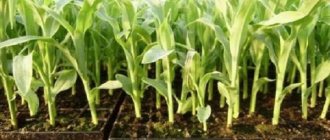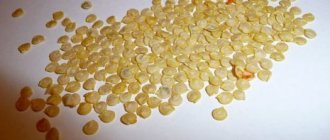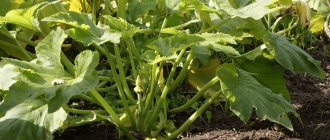Features of growing and rules for caring for kohlrabi in open ground
Kohlrabi cabbage, unlike its white cabbage relative, is not so often found in local gardens.
And it’s completely in vain, because it has undeniable advantages: it’s easy to grow—planting and caring for kohlrabi in open ground can be done even by a beginner—and the fruits are rich in vitamins and minerals.
What is kohlrabi, photo, taste, color
Kohlrabi cabbage is a biennial herbaceous plant that develops a productive stem organ in the first year, and flowers and seeds by the next year. The plant belongs to the cabbage family; its name translated from German means cabbage turnip . Although our climate is far from what is usual for kohlrabi, it can be grown without difficulty in most of Russia and in other regions with a temperate climate.
The plant is cross-pollinated and requires moderate temperatures and fertile soils.
The taste of kohlrabi is somewhat reminiscent of the stalk of simple white cabbage, but much tastier, juicier and sweeter. Kohlrabi leaves contain 2 times more vitamins than the stem fruit, and a lot of calcium and iron. Therefore, thin kohlrabi leaves should not be thrown away. The leaves are cut into narrow strips and used in salads.
Kohlrabi cabbage most often comes in a variety of colors : pale green, yellow, purple, pink. The pulp of the stem fruit is always white or light beige. The shape of the stem fruit, depending on the variety, can be round, oblong or flattened, like a turnip. The size of the vegetable can range from 0.2 to 1 kg.
History and origin
It is believed that the birthplace of this cabbage was the Mediterranean, from where it was later transported to East Asia and Europe.
Kohlrabi has been eaten for a long time, but the first written evidence of the cultivation of this cabbage is found in the chronicles of Ancient Rome. At that time, this vegetable was present on the tables of slaves and the poor. In the Middle Ages in Europe, kohlrabi became the food of rich people.
This culture was brought to Russia by Peter the first after his European journey. The king was so amazed by the unusual appearance of the vegetable and its taste that he decided that kohlrabi must be grown in Rus'. Of all the names for this cabbage, the German name has stuck, literally translated as “turnip cabbage.”
Chemical composition
Kohlrabi is rich in proteins, carbohydrates, vitamins C, BP B2, PP, pantothenic and especially ascorbic acid, mineral salts of potassium, magnesium, iron, sodium, iodine, calcium and phosphorus, and is superior to most vegetable crops in the content of the last 2 elements. Contains enzymes, fiber and other biologically active substances.
Early and late varieties of kohlrabi
How to choose the best varieties and what to focus on? First of all, decide why you are planting this cabbage. If you want to diversify your summer menu and enjoy juicy pulp straight from the garden, then the following early and early ripening varieties : Atena, Vienna Violet, Delicatessen Red, Piquant, Smak.
If you want your harvest to be stored all winter, then choose from late-ripening varieties , for example, Violetta, Gigant, Blue Planet.
Insect pests, diseases and their control
Kohlrabi, unlike other members of the cruciferous family, is less susceptible to diseases and attacks by harmful insects. But the possibility of their occurrence cannot be completely ruled out. The following diseases can affect the crop:
- spotting;
- viral mosaic;
- blackleg;
- cabbage clubroot;
- vascular bacteriosis;
- fusarium;
- underwear;
- powdery mildew;
- rot;
- Alternaria blight.
Pests that pose a potential threat to cabbage include:
- slugs;
- aphid;
- scoop;
- click beetles;
- cabbage flies;
- wireworms;
- cabbage whites;
- cabbage bugs;
- mole crickets;
- cruciferous flea beetles;
- thrips.
Folk remedies and chemical preparations - insecticides - will help in the fight against insects. For fungal infections, fungicides are used. Viral infection (mosaic) and some bacterial diseases cannot be treated - the affected plants must be destroyed.
It is important to remember about preventive measures so as not to encounter kohlrabi contamination in the future: purchase high-quality seeds;
- carry out pre-sowing treatment of planting material (warming);
- choose a plot for cabbage taking into account the rules of crop rotation;
- treat the soil under the plants with ash;
- remove weeds from the beds in a timely manner;
- regularly inspect the plantings;
- destroy bushes with signs of incurable infection.
Growing kohlrabi and care in open ground
Grows well in areas with average fertility. To obtain the finished product ahead of schedule, it can be cultivated with seedlings.
In the first half of the growing season, kohlrabi responds very well to dry and non-wet seasons. The areas with cabbage turnips should receive the maximum amount of sunlight. Shading from nearby trees greatly reduces crop yield. The stem fruit develops well only in full sun, at a temperature of 12-18 ° C.
Predecessors
Kohlrabi grows well and bears fruit if it is placed after: tomatoes; pumpkins; potatoes; carrots; zucchini, herbs.
Kohlrabi should not be placed after crops from the Brassica family for at least 4 years. Plants of the cruciferous family have the same pests, therefore, bad predecessors: cauliflower, white cabbage, broccoli, Chinese cabbage, horseradish, radish, red cabbage, rutabaga.
Good neighbors for kohlrabi: beans, peas, lettuce.
The maximum soil moisture should be 65-70 percent HB. During the formation of a productive organ, soil moisture should be at the level of 75-80 percent HB.
Lack of moisture often leads to the formation of coarse pulp, and its fluctuations lead to cracking. Kohlrabi can be grown in a conveyor belt with other vegetable crops.
- If there is not enough space for a kohlrabi bed, then it can be planted between other crops as a compactor. She gets along well with almost all her neighbors.
Kohlrabi seedlings
The substrate for growing kohlrabi seedlings can be purchased at the retail chain. Many vegetable growers prepare it themselves using this algorithm:
- mix turf soil, peat, sand in equal proportions;
- disinfect the resulting substrate with a solution of potassium permanganate.
In parallel with soil preparation, seed material should be prepared in the following sequence:
- seeds are exposed to warm water for 15 minutes;
- after being removed from the water, the seeds are immersed in cold water for 2 minutes for rapid cooling;
- the seeds are kept for 12 hours in a solution of the stimulant “Epin” or “Kornevin”, the stimulator is diluted in water according to the instructions;
- after removing the stimulant from the solution, the seeds are washed and placed in the refrigerator for 24 hours for hardening;
- On the day of sowing, the seeds are removed from the refrigerator and dried.
When sowing, each seed is sown in a separate pot or sown in special boxes. The planting depth is maintained within 1 cm or slightly deeper. When sowing in boxes, adhere to a planting pattern of 3 by 3 cm. After sowing, you need to moisten the substrate and cover the containers with film. The film is lifted daily to change the air.
Caring for kohlrabi seedlings is no different from caring for white cabbage. The same fertilizers will suit you, and watering can be done at the same intervals. In the phase of 2 true leaves, kohlrabi seedlings are sprayed with a 0.4% superphosphate solution (40 g per 10 l of water). Two weeks before planting in the ground, spray with a solution of potassium sulfate and urea (1 tablespoon of each preparation per 10 liters of water).
The ideal temperature for seedlings is no less than 12 ºC and no more than 16 ºC. After 4 days, the first shoots will appear, the film is removed and, in order to avoid stretching the seedlings, the temperature is lowered to +10 degrees. After a decade, the temperature is raised again to +18 degrees.
To obtain a faster harvest, kohlrabi is grown after 35-40 days of seedlings, that is, like early cabbage. The time for early planting of seedlings is determined by the readiness of the soil and the possibility of its cultivation.
When growing seedlings in the soil of a greenhouse, nursery or in a seed box (15 cm high), 4-5 days before planting, the soil mixture is cut lengthwise and crosswise between the plants with a knife. This promotes the formation of root lobes in the cutting areas and the preservation of a lump of earth when removing seedlings from a box or greenhouse.
You may be interested in - Growing Savoy Cabbage
Kohlrabi pick
Seedlings of this variety of cabbage do not tolerate picking well, so seedlings are grown in separate containers. But if you sowed the seeds in a common box, plant them in the development phase of the first true leaf in peat-humus pots. Immediately after picking, the temperature should be about 20 ºC, but after a few days the temperature is set to 17 ºC during the day, and 11 ºC at night.
Two weeks before planting seedlings in open ground, hardening procedures are carried out, gradually accustoming the seedlings to the sun's rays, wind and outdoor temperature. You should not rush to plant seedlings in the garden, as cold weather can cause shoots to form.
When planting early, it is recommended to cover the plants with non-woven material at night.
Selecting a seat
Successful cultivation and care of kohlrabi cabbage is possible with strict adherence to agricultural technology. The technology of crop cultivation includes many points. Cultivation begins with choosing a planting site. Kohlrabi has a short growing season and, if you choose the right site, you can get 2 harvests during the warm season.
Climate requirements
- Light. The areas with cabbage turnips should receive the maximum amount of sunlight. Shading from nearby trees greatly reduces crop yield. The stem fruit develops well only in full sun, at a temperature of 12-18 ° C.
- Wind. Windless places on southern or southeastern slopes are desirable.
- Temperature requirement . Kohlrabi easily adapts to the growing conditions characteristic of central Russia and tolerates temperature changes well. In the Moscow region it grows until mid-October. The vegetable is sensitive to low temperatures; after 10 days of temperatures below 5 ° C, it begins to produce seeds. On the other hand, high temperatures without precipitation cause lignification of the stem, and prolonged rains can cause it to crack.
Soil requirements
The soil should be fairly fertile, well-drained, with a neutral, or close to neutral, slightly acidic reaction of the soil solution, ideally 6.0-6.5. Low, waterlogged places are not suitable for kohlrabi.
Predecessors
Kohlrabi grows well and bears fruit if it is placed after:
- tomatoes;
- pumpkins;
- potatoes;
- carrots;
- zucchini.
Kohlrabi should not be placed after crops from the Brassica family for at least 4 years. Bad predecessors:
- cauliflower,
- White cabbage,
- broccoli,
- Chinese cabbage,
- horseradish,
- radish,
- red cabbage,
- swede.
The plant will be affected by pests and diseases that affect crops of this family.
When choosing a planting site, you need to pay attention so that kohlrabi does not grow next to other plants from the cabbage family.
Good neighbors for kohlrabi:
- beans,
- peas,
- salad.
Watering
Cabbage especially needs proper watering during the formation of the stem crop. Its deficiency can negatively affect formation, and its excess can lead to cracking.
It is important to avoid stagnation of water and at the same time maintain moderate humidity.
To combat pests and diseases, the same means are used as for white cabbage. Loosening occupies a special place. It helps saturate the soil with oxygen. It is important to carry out this carefully so as not to damage the stem and not to cover it with soil.
Fertilizers
Since kohlrabi is an early ripening variety, mineral fertilizers are mainly applied to it. Fresh manure is not used for this crop, since it is used to a small extent. If the soil of the site is acidic, then kohlrabi, like other plants of the cruciferous family, is severely affected by a fungal disease - cabbage clubroot.
How to plant kohlrabi
If the goal is not to grow kohlrabi at the earliest possible time, you can use the seedless method. To do this, furrows are made in the garden beds, 2 cm deep, and in mid-June they are sown with dry seeds. You can pre-prepare the seeds as described above. In the process of growing young plants, they are thinned out, removing weak, diseased specimens
In order to get an earlier harvest , kohlrabi seedlings are planted in open ground more densely: therefore, the distance that should be between rows is seventy centimeters, between plants - 10 centimeters, with the calculation of thinning plants by twenty to twenty-five centimeters in rows as how the stem fruits ripen.
For planting, choose a cloudy day or evening after sunset. Before planting, add 2 tablespoons of superphosphate, a teaspoon of urea, and 2 cups of wood ash into each hole.
To plant seedlings, make holes, fill them with cold water or a fertilizer solution (2-3 tablespoons of garden mixture per bucket of water) so that the pots with seedlings that are placed in these holes are covered with water. The pots are saturated with water, and there is no need for watering after planting. The roots of seedlings grown without pots are dipped into a clay mixture with mullein before planting. The later post-planting watering is carried out, the deeper the roots will go into the soil, the better the plant will be nourished. When the moisture is absorbed, the hole is covered with earth, but the apical bud cannot be covered, otherwise there will be no stem fruit.
Seedlings are planted, deepening them up to the cotyledon leaves, since deeper planting can delay the formation of stem fruit or provoke flowering. The roots of kohlrabi should be placed near the surface of the soil and only lightly sprinkled with soil. After planting, trample the soil slightly, water it abundantly, and when the water is absorbed, sprinkle the area with dry soil so that the moisture does not evaporate so quickly.
Three weeks after planting the kohlrabi seedlings in a permanent place, the cabbage needs to be hilled up, and then repeat this procedure after another two weeks. Even if you sowed kohlrabi directly into the ground, it needs regular hilling. It is carried out for the first time in the phase of 5-6 true leaves, when the formation of the stem fruit begins. And then at intervals of 15-20 days.
Growing kohlrabi cabbage from seeds to seedlings
To obtain an early harvest, seedlings are grown on windowsills. This method allows you to get stem fruits already at the beginning of summer. Kohlrabi cabbage is grown from seeds for seedlings in mid-March. It is important to prepare planting material to reduce the risk of diseases such as powdery mildew, blackleg, and various fungal infections.
How to process planting material:
- You need to place the seeds in a cloth and soak for half an hour in hot water at 50-60 degrees.
- Cool 10 minutes in cold water.
- Leave for 12 hours for the seeds to swell in a room at room temperature.
- Place in the refrigerator for a day.
- For flowability, the seeds can be dried a little by holding them in the air.
Sowing is carried out in pre-prepared soil, consisting of sand and turf soil in a 1:1 ratio. You can add a little humus and ash. To disinfect the soil, it is spilled with a solution of manganese (1 gram per 10 liters of water). You can grow kohlrabi cabbage from seeds for seedlings directly into individual cups or boxes with subsequent picking. The second method is better, as it allows you to get stronger and stronger plants.
For sowing, grooves are cut in the soil at a distance of 3-4 cm from each other. The seeds are planted to a depth of 1 cm, the distance between them is maintained at 1-2 cm. Sprinkle the top with loose soil and put the box on the windowsill. When seedlings appear, it is necessary to remove the seedlings to a cooler place with a temperature of 10-15 degrees for several days to prevent the plants from stretching. After 2 weeks, you can start picking into individual cups. The stem fruit can be grown both in greenhouses and open ground.
Pests
In nature, there are many pests of vegetable crops that want to feast on the leaves and stems of kohlrabi. The most harmful are the following:
- cruciferous flea beetle;
- wireworm;
- cabbage fly;
- scoop;
- cabbage aphid;
- whitefish;
- mole cricket;
- slug;
- fire;
- mole.
Snails and slugs often attack plants, especially on humid summer days. They are not easy to spot because they hide during the day and attack the beds at night when the humidity rises. Slugs feed on leaves and stems and damage crops. A damaged vegetable quickly turns brown and withers.
The most dangerous pest of cabbage is the cabbage fly . She lays eggs on the ground, near the stem or on the stem of the seedling, from which larvae hatch after 5-6 days - white worms. They bite into roots and stems. It is recommended to rake soil contaminated with eggs from plants and add fresh soil. Then the eggs and larvae will die.
Damage is also caused by birds and hares that eat the leaves and kohlrabi crop.
In case of severe pest infestation, plantings are sprayed with insecticides: Corsair, Actellik, Karate, Decis, Aktara, Ambush, Decis, Rovikurt, etc.
Fungicides Quadris, Skor, Topaz will cope with fungal diseases
Well, if your plantings are affected by bacterial diseases , then all the affected plants will have to be removed and disposed of (not in compost), the bed in this place should be spilled with a dark pink solution of potassium permanganate and nothing will be planted on it this year.
Plant care
Growing and caring for kohlrabi does not require additional knowledge and skills. The list of works includes:
- systematic watering;
- weeding;
- feeding;
- loosening the surface of the beds.
Attention! When the cabbage has 7 true leaves, the laying of the stem fruit begins. At this point it is important to perform hilling.
Watering
Growing kohlrabi in a permanent place should be accompanied by regular watering. At the first stage, water the cabbage moderately, every other day. After some time, when the plant gets stronger, the number of waterings is reduced to 1-2 times a week.
The vegetable does not tolerate drought. Lack of water leads to woody stems; too much rain can lead to cracking.
The soil around the plant should be moderately moist. In the intervals between irrigations, weeding and loosening of the soil are performed.
Feeding
Kohlrabi has a high demand for nitrogen and potassium due to its relatively rapid growth. If the vegetable is grown on a high agrotechnical background and all recommended fertilizers are applied before planting, then there is no need to apply them during the growing season.
Excess nitrogen can lead to an increase in nitrate content in the stem crop.
You can limit yourself to sprinkling the soil under the bushes with wood ash.
If the beds are not properly filled with fertilizers, it is necessary to fertilize three times a season.
In a bucket of water dilute:
- potassium sulfate – 30 g;
- ammonium nitrate – 25 g;
- superphosphate – 28 g.
All substances need to be dissolved, stirring, then pour the solution under the roots of the plants at the rate of 5 liters per m².
Collecting seeds
Kohlrabi is a biennial plant. Reproduction can be successfully carried out independently. If the plant is not pulled out in the first year, but protected over the winter with compost or straw, it will grow and bloom the following year. Mature seeds just need to be collected, dried and prepared for sowing next spring. However, there is no guarantee that the seeds will produce pure kohlrabi. The tuber is no longer edible in its second year.
Diseases
Kohlrabi can be affected by diseases and pests.
The most common diseases are:
- powdery mildew;
- clubroot;
- downy mildew;
- blackleg;
- dry rot;
- bacteriosis;
- Alternaria blight;
- ring spot.
Black mold of cabbage seeds, caused by Alternaria fungi, causes brown spots to form on the leaves. The disease mainly affects the plant in rainy weather. The plant develops brown or black spots, especially on the stem and leaves. The spots are usually concentric and may have a yellow edge. Over time, they become necrotic and break the leaf. Brown spots appear on the head of the kohlrabi. Over time, the plant dies.
Downy mildew is a fungal disease caused by the fungus Hyaloperonospora brassicae. Recognized by yellow spots on the upper side of the leaf and white mycelium blooming on the underside of the leaf.
Downy mildew and black mold of cabbage can spoil the kohlrabi fruit. The reason may be low temperatures, which stimulate the plant to flower, or the substrate being too compacted. The leaves die over time and the kohlrabi head may become distorted and rot. The main causes of the disease are high soil and air humidity and lack of proper hygiene of the beds.
Cabbage white rust, caused by the fungus Albugo candida, is recognized by white raised areas containing fungal spores on the stems.
Gray mold - covers the stem with a gray, fluffy coating.
Sclerotinia is manifested by a white coating of mycelium.
In the fight against diseases, preventive measures and compliance with agricultural cultivation techniques are of great importance:
- use healthy seed;
- prepare seeds before sowing;
- after harvesting, remove plant debris from the beds;
- dig the soil deeply in the ridges after harvesting;
- select varieties that are resistant to diseases.
If an outbreak of the disease occurs, it is necessary to apply treatment with antifungal or bactericidal drugs.
Every plant needs water for proper development; proper irrigation is very important. Excessive watering of the plantation quickly leads to the development of fungal diseases. High humidity is ideal conditions for spore development. Especially when it comes to cabbage clubroot, which is practically untreatable.
Pests
In nature, there are many pests that want to feast on the leaves and stems of kohlrabi. The most harmful are the following:
- cruciferous flea beetle;
- wireworm;
- cabbage fly;
- scoop;
- cabbage aphid;
- whitefish;
- mole cricket;
- slug;
- fire;
- mole.
Snails and slugs often attack plants, especially on humid summer days. They are not easy to spot because they hide during the day and attack the beds at night when the humidity rises. Slugs feed on leaves and stems and damage crops. A damaged vegetable quickly turns brown and withers.
The cabbage aphid is a small light green fly. The insect feeds by sucking the sap of plant cells. The plant loses turgor and does not grow properly. Aphids are dangerous throughout the growing season; they can develop 8-12 generations. Eggs are often spread on care equipment and on seeds purchased from unverified sources.
Spraying with dandelion infusion against aphids To prepare the infusion, 200-300 g of crushed dandelion roots or 400 g of fresh leaves or flowers are poured with 10 liters of water at a temperature of 30-40 ° C, left for several hours to cool. The mixture is filtered and used regularly, spraying the beds.
Damage is also caused by birds and hares that eat the leaves and kohlrabi crop.
To control the number of these insects, it is important to follow the described cultivation techniques. Seeds should be purchased only from trusted sources that do not allow diseases and pests to be transferred to the beds. Pests often hide in weeds from the same family. It is important to remember to decontaminate equipment used to care for cabbage. Fungal spores and pest eggs are found, for example, on hoes or even tractor wheels. It is better to carry out all work with gloves for our safety and to protect the crop.
If there is a significant spread of pests, you need to join the fight by spraying the plantings with the following preparations:
- Corsair;
- Aktellik;
- Karate;
- Decis;
- Aktara.
Important! The packaging of the drugs contains instructions for use, which should be strictly followed.
Kohlrabi harvest
Kohlrabi is harvested when the stem reaches approximately eight centimeters in diameter and weighs about one hundred grams. The plants are cut off, leaving only a short stump, about one and a half centimeters long, and the leaves are removed. To store them for long-term storage, they are pulled out by the roots and the leaves are cut off.
Spring-sown cabbage is harvested as it ripens, but can be stored in the refrigerator for no more than two weeks. But kohlrabi, sown from the end of June to the end of July, is harvested at approximately the same time as white cabbage - when the daytime temperature drops to 3-5 ºC, and the night temperature stays within 0-1 ºC.
By this time, the stem fruits should reach 8-10 cm in diameter and weigh from 90 to 120 g. The average yield per 1 m2 is 2-3 kg.
When overripe, kohlrabi cabbage becomes coarse and fibrous, which does not at all improve its taste. Kohlrabi cabbage has good shelf life, but its storage requires certain conditions to be met, and first of all, maintaining a high level of humidity in the room. Purple-colored kohlrabi is stored best than others.
Dried kohlrabi is put into the basement or cellar, where, provided the humidity is 95% and the temperature is not higher than 5°C, it can be stored for more than six months. It will be best to lie in boxes with sand, and the fruits should not touch each other.
Kohlrabi can also be blanched and frozen, or stored in the refrigerator for 2-3 weeks, wrapped in film or paper.
Collecting seeds
Reproduction can be successfully carried out independently. If the plant is not pulled out in the first year, but protected over the winter with compost or straw, it will grow and bloom the following year. Mature seeds just need to be collected, dried and prepared for sowing next spring.
Reviews from gardeners
★★★★★
Natalya, 47 years old, Southern Urals. This is only the second year I’ve been planting kohlrabi, the Viennese white variety.
I like it in salads, grated. I pick it young, then it is tender and tasty. Over the summer I destroy the entire crop, and in the fall other cabbages are suitable. ★★★★★
Oksana, 35 years old, Yekaterinburg. I just love kohlrabi!
It is not worth growing it to large sizes, because hard fibers appear and it becomes less juicy. I like the purple varieties the most. It is very useful due to the large amount of silicon. ★★★★★
Oleg, 56 years old, Moscow region. I planted a hybrid kohlrabi, Korist.
A very juicy vegetable, eat it like an apple! But what I liked most about it is that it does not form coarse fibers and does not overgrow. This year I will try to plant this variety twice: with seedlings in the spring, and then in open ground in the summer. Hide
Add your review
Growing kohlrabi cabbage is not very difficult, especially for those people who have already grown other types of cabbage on their plot. During the season you can get 2 or even 3 harvests and enjoy this vegetable throughout the summer.
0
0
Copy link
Tips and tricks
- It is strictly not recommended to water kohlrabi using the sprinkling method, as this often leads to the spread of downy mildew.
- Plants must be well ventilated and receive enough sun, so planting density should be maintained.
- Before planting seedlings, the roots can be dipped in a mash of clay and mullein with the addition of the biological product Fitolavin.
- Kohlrabi is absolutely unpretentious to its neighbors. It easily gets along in the aisles of tomato, cucumber and carrot beds.
- Several varieties of kohlrabi with different ripening periods should be planted at once - this will allow you to have a harvest from early summer to late autumn.
- It is not recommended to apply fresh manure under cabbage. It is better to use humus and bird droppings from organic matter.
- The Russian climate suggests growing kohlrabi cabbage mainly in seedlings. The vegetable is grown at home in nurseries or heated greenhouses.
The best varieties
Giant
The giant is resistant to heat and drought, so it thrives in the southern regions of our country. It has juicy white flesh. The fruit itself can reach a weight of up to 5-6 kg.
Violet
A late variety, it is resistant to frosty weather and can grow to a weight of 1-1.5 kg.
Moravia
The Moravia variety was developed in the Czech Republic. It has juicy pulp, and the fruit itself can reach a weight of up to 2-2.5 kg.
Atena
The weight of the Atena variety is from 3 to 3.5 kilograms. Their flesh is approximately the same: juicy and tender. This cabbage makes excellent salads.
Viennese
Viennese has a purple hue, the mass of the stem fruit is small - about 1 kg. Despite its good taste, this variety is not stored for a long time and is suitable for fresh consumption immediately after harvest.
Piquant
Pikant is resistant to cracking and practically does not lend itself to the process of lignification. Weight is approximately 1-1.5 kg. Its pulp is especially tender and juicy; it is very good for preparing fresh salads.
Delicatessen
Frost-resistant variety Delicatessen red. It has white flesh, tender and juicy. The weight of the fetus reaches 2-2.5 kg.
Blue planet
The Blue variety stores well. This variety is a hybrid, having a fruit weighing up to 300 grams. It is not prone to cracking, so it can be stored for quite a long time.
What fertilizers are good for the crop?
Kohlrabi is not a very demanding crop, but it is advisable to enrich the soil with nitrogen. This is done in order to ensure proper growth of the stem. It is recommended not to oversaturate the soil with mineral and nitrogen fertilizers, so as not to oversaturate the amount of nitrates in the root crop. It is better to use wood ash, which is introduced into the place where the root is located.
It is allowed to enrich the soil if it is completely depleted. In this case, classic recipes of superphosphate, potassium sulfate and ammonium nitrate are used. How to use the substances is written on the packaging by the manufacturer. Usually the procedure is simple and depends on diluting the powder with water.
Seed cultivation
It is better to start growing kohlrabi from seeds in mid-winter.
Sowing seeds is used to obtain a late harvest. Plant the seeds in the open ground of a greenhouse or greenhouse. The technique for growing kohlrabi from seeds in the open ground is almost the same as growing its seedlings at home. Crops should be insulated using covering material.
Soil preparation
The soil at the dacha must be fertile. Also, the place should be well lit. Be sure to fertilize the soil with a tincture of fresh manure before planting. Just mix it with a few liters of water and leave it to steep for 5-7 days.
It is not recommended to place fresh manure on the soil, as this increases the risk of infecting the fruits with parasitic insects.
Kohlrabi is best planted after onions, cucumbers or zucchini.
It is necessary to plant in the early period, before planting tomatoes, vegetable beans and other vegetable crops. Because it will create a shadow - it will preserve tomatoes, tomatoes or beans that have not yet matured. And when they get older, stronger and more mature, the kohlrabi will be removed.
How to plant
If you want to once again protect kohlrabi from insect pests, then experienced gardeners and farmers advise doing the following. Simply plant kohlrabi seedlings next to herbs such as basil or hyssop. Perennial onions will also help in the prevention and control of diseases and pests. And, in principle, kohlrabi cabbage will “appreciate” any neighborhood in a garden bed with fragrant herbs.
A distance of 20-25 cm between plants and about 30-35 cm between rows is sufficient. This type of cabbage does not need to be planted too deep in the soil, as the fruit will form on the stem.
Possible errors and problems
Most gardeners are faced with the fact that the ovaries of seedlings rapidly grow upward, quickly weaken, and lose their normal appearance. The main reason for this is dense planting, improper organization of light and temperature.
Cabbage sets well when planted sparsely, in the correct proportions - this will help the light saturate the bushes. The distance between seedlings should be at least 5 cm. Additional light can be provided. For this, special lamps are used.
Expert opinion
Stanislav Pavlovich
Gardener with 17 years of experience and our expert
Ask a Question
It is not recommended to replant seedlings until mid-March. Temperature fluctuations before the formation of the first ovaries are 12-14°C, this temperature should remain for 4-5 days.
Conditions for planting cabbage-turnips
Cabbage, like other types of cruciferous vegetables, is demanding of heat, humidity and soil fertility.
It can be planted either in a separate area or as a compactor for other vegetable beds, in places enriched with nitrogen. If kohlrabi has already grown in the garden, then it can be returned to its original place only after 3-4 years. Kohlrabi is more successful in central Russia, as it prefers high humidity (more than 75%) and average air temperature (18-20 degrees). It does not tolerate heat, drought and constant precipitation - it immediately cracks, dries out, becomes woody, and becomes tasteless. At the same time, kohlrabi, especially seedlings, tolerate a slight drop in temperature well. Although you should not experiment with this - when planting early, it is better to keep the plantings under film. Attention!
This culture reacts sharply to chemical treatment. Their concentrated composition can burn the foliage and make the fruit unfit for consumption. Therefore, kohlrabi is grown without the use of chemicals.
Nutritional value and beneficial properties
Kohlrabi is a vitamin-rich vegetable. It contains vitamins E, PP, B6, B5, B2, K, B1, C, A, B9. As well as such useful substances as potassium, phosphorus, manganese, iron, selenium.
Nutritional value per 100 g of product:
- proteins 2.9%;
- water 86.3%;
- dietary fiber 1.8%;
- carbohydrates 7.8%;
- fats 0.2%;
- ash 1.3%.
Attention: Kohlrabi is a low-calorie vegetable; this cabbage can be consumed as part of a diet. 100 g of product contains 45 kcal.


